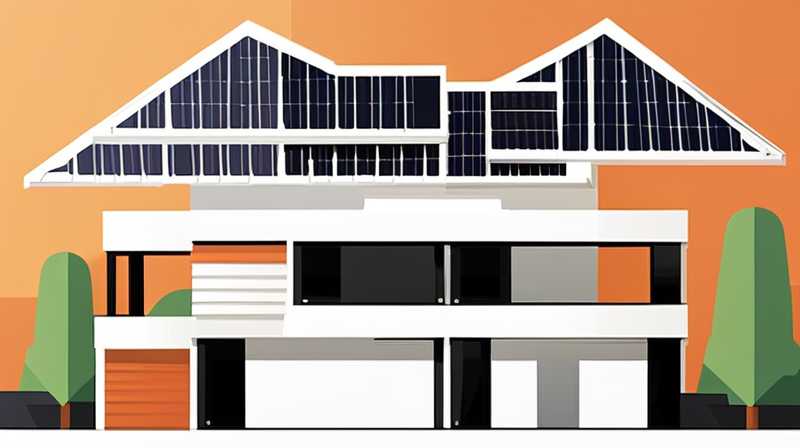
To effectively manage solar energy through roof sunshades, one must consider several key factors: 1. Assessing Optimal Placement, 2. Selecting Appropriate Materials, 3. Understanding Energy Efficiency, 4. Evaluating Aesthetic Integration. Each factor plays a crucial role in maximizing energy capture and ensuring that the system functions seamlessly with existing architecture.
When deciding on the optimal placement of solar panels on roof sunshades, it is important to evaluate the orientation and angle to capture maximum sunlight. South-facing panels without obstructions tend to receive the most solar exposure throughout the day. Furthermore, ensuring that there is no shading from trees or buildings during peak sunlight hours increases efficiency substantially. Apart from sun positioning, the angle of the solar panels can be adjusted to correlate with seasonal variations in the sun’s trajectory. This configuration allows collectors to capture the most energy throughout the entire year, vastly improving their productivity.
The choice of appropriate materials can significantly affect energy generation efficiency. High-quality solar cells made from monocrystalline or polycrystalline silicon offer better performance in low-light conditions compared to thin-film alternatives. Moreover, the durability and weather resistance of materials used in constructing sunshades or mounting systems can prolong the lifespan of solar installations. Ensuring components are robust enough to withstand inclement weather enhances longevity and reliability for long-term energy production.
A comprehensive understanding of energy efficiency through solar energy harnessed from roof sunshades requires thorough knowledge of system productivity. Factors such as inverter quality, battery storage capabilities, and grid connectivity contribute to overall energy management. Solar inverters convert direct current (DC) from solar panels into alternating current (AC), which is utilized in homes. Selecting high-efficiency inverters can maximize power output considerably. Additionally, incorporating battery storage enables homeowners to utilize solar energy even during periods of low sunlight, mitigating reliance on grid power.
Furthermore, evaluating aesthetic integration is paramount when considering the installation of solar panels on roof sunshades. Homeowners should ensure that the design complements their residence while being functional. There are numerous innovative designs available that blend seamlessly with existing architectural styles, minimizing visual disruption. Options exist for customizing panel sizes, shapes, and colors, merging functionality with appearance. Sustainable designs can enhance property value while contributing to environmental conservation.
Understanding the influences solar energy has on home utility bills remains a vital aspect. The installation of solar panels ultimately leads to substantial savings on energy costs. As the number of energy-efficient homes grows in popularity, the trend towards solar dependency continues to gain momentum. Solar energy also provides reduced carbon footprints, necessitating community awareness about environmental benefits.
In the context of potential challenges associated with solar energy on roof sunshades, it is notable that initial installation costs can be high. Homeowners need to assess financing options such as government incentives or rebates tailored for renewable energy. Understanding the long-term savings against upfront expenditures is crucial. Many families find that subsequent savings on utility bills justify the initial financial outlay, fostering economic sustainability.
FREQUENTLY ASKED QUESTIONS
HOW DOES SOLAR ENERGY GENERATION WORK?
Solar energy generation involves capturing sunlight through solar panels: 1. Solar cells convert sunlight into electricity, 2. The inverter changes the electricity from DC to AC, 3. The energy is either used directly or stored in batteries, 4. Excess power may feed back into the grid. The operational principle relies on the photovoltaic effect, where solar cells generate electron movement when exposed to light. This movement creates a flow of electric current, which can be harnessed and used for various applications, making solar panels viable for home energy needs.
WHAT ARE THE BENEFITS OF INSTALLING SOLAR PANELS ON ROOF SUNSHADES?
There are numerous advantages to installing solar panels in conjunction with roof sunshades: 1. Enhanced energy efficiency, 2. Reduced carbon footprint, 3. Potential utility savings, 4. Increased property value. By capturing sunlight while providing shade, these installations maximize energy production without compromising outdoor comfort. Moreover, the eco-friendly aspect of using renewable energy significantly lowers greenhouse gas emissions, contributing positively to the environment. Homeowners may also find that integrating solar panels into existing structures raises real estate values, further incentivizing investment.
IS MAINTENANCE OF SOLAR PANELS COMPLICATED?
Maintaining solar panels is relatively simple: 1. Regular cleaning of panels to remove dirt and debris, 2. Annual inspections for performance efficiency, 3. Monitoring energy output to detect abnormalities. Unlike other home maintenance tasks, solar panel upkeep is minimal. Dust accumulation can hinder energy capture, so it is essential to ensure cleanliness. Annual inspections allow professionals to verify systems’ functionality, providing peace of mind regarding energy generation efficiency. By routinely monitoring performance, homeowners can detect and address issues promptly, ensuring their systems operate effectively.
It is paramount to recognize how effectively harnessing solar energy through roof sunshades may contribute to sustainable living. Embracing solar technology marks a critical transition towards reducing dependency on fossil fuels while optimizing natural resources. The proactive approach encompasses a range of practical and financial benefits that can lead to long-term satisfaction. Exploring solar energy solutions will not merely improve individual residences but could initiate community-wide benefits, reminiscent of a broader ecological mindset. Embracing renewable energy fuels a healthy dialogue concerning sustainability that extends beyond personal desires, amplifying awareness of environmental stewardship.
A diligent commitment to solar energy integration on roof sunshades yields profound results that transform how homes consume energy. Individuals can take control of their energy consumption patterns while contributing to global environmental initiatives. The journey toward renewable solutions presents challenges, yet it equally uncovers opportunities for significant advancement in energy management. It is a multifaceted issue that requires careful consideration and deliberation to optimize results. More than just an investment in personal comfort, solar initiatives reflect broader societal values prioritizing sustainability and responsible resource management. The pursuit of solar energy on roof sunshades is not just about harnessing power; it is fundamentally about crafting a greener, more sustainable future for generations to come.
Original article by NenPower, If reposted, please credit the source: https://nenpower.com/blog/how-to-deal-with-solar-energy-on-roof-sunshade/


